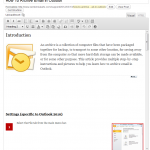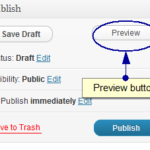Introduction
Before posting your first post through WordPress, you might want to know about all the features it has and what they mean. Each tool has a different purpose and this glossary will help you understand each term before starting empty-handed with your first post. This list of terms and tools will keep you from being lost and confused when reading the other articles of support on WordPress, such as Tips on Visual/HTML, How to Write/Post an Article, and others.
Title
 The title of your post is located at the top of your post in a long white box. You can use any words or phrases but make it relevant to your post. You can use commas, apostrophes, quotes, hyphens/dashes, and other typical symbols in the post.
The title of your post is located at the top of your post in a long white box. You can use any words or phrases but make it relevant to your post. You can use commas, apostrophes, quotes, hyphens/dashes, and other typical symbols in the post.
Post Editing Area
 This is the big blank box where you enter your writing, links, images, and any information you want to display on your site. You can use either the Visual or the HTML view to compose your posts. For more on the HTML versus Visual view, see the article over How to Edit Visual/HTML.
This is the big blank box where you enter your writing, links, images, and any information you want to display on your site. You can use either the Visual or the HTML view to compose your posts. For more on the HTML versus Visual view, see the article over How to Edit Visual/HTML.
“Publish” box
 This box is located to the right of the screen towards the top. It contains the main options of Publish, Preview, and Save Draft. The status section is what the current post is viewed as. This can be set as Published, Pending Review, or Draft. The visibility section determines how your post is viewed on the internet. These settings can be changed to Public, Password Protected, or Private. You can also set the time and date (if desired) that you want the post to be published with the publish section, or you can choose to publish your post immediately.
This box is located to the right of the screen towards the top. It contains the main options of Publish, Preview, and Save Draft. The status section is what the current post is viewed as. This can be set as Published, Pending Review, or Draft. The visibility section determines how your post is viewed on the internet. These settings can be changed to Public, Password Protected, or Private. You can also set the time and date (if desired) that you want the post to be published with the publish section, or you can choose to publish your post immediately.
“Publish” section
Located in the Publish box, the publish section allows you to set the time and date (if desired) that you want the post to be published, or you can choose to publish your post immediately.
“Publish” button
Clicking the big blue Publish button will publish your post on the internet site, according to the publish section settings.
“Status” section
 Located in the Publish box, you can choose what the status of your post is. A Published status means the post has been published on your blog for all to see. Pending Review means the draft is waiting for review by an editor prior to publication. Draft means the post has not been published and remains a draft for you to continue editing.
Located in the Publish box, you can choose what the status of your post is. A Published status means the post has been published on your blog for all to see. Pending Review means the draft is waiting for review by an editor prior to publication. Draft means the post has not been published and remains a draft for you to continue editing.
“Visibility” section
 Located in the Publish box, visibility determines how the post is viewed on the internet. Public posts will be visible by all website visitors once published. Password Protected posts are published to all, but visitors must know the password to view the post content. Private posts are visible only to you (and to other editors or admins within your site).
Located in the Publish box, visibility determines how the post is viewed on the internet. Public posts will be visible by all website visitors once published. Password Protected posts are published to all, but visitors must know the password to view the post content. Private posts are visible only to you (and to other editors or admins within your site).
Password Protect This Post
 To password protect a post, click Edit next to Visibility in the Publish box. Then click Password Protected > OK and then enter a password. Click OK again.
To password protect a post, click Edit next to Visibility in the Publish box. Then click Password Protected > OK and then enter a password. Click OK again.
Save Draft
 Located in the Publish box, this allows you to save your post as a draft/pending review rather than immediately publishing it. To return to your drafts later, visit Posts > Edit in the menu bar, then select your post from the list.
Located in the Publish box, this allows you to save your post as a draft/pending review rather than immediately publishing it. To return to your drafts later, visit Posts > Edit in the menu bar, then select your post from the list.
“Preview” button
 Located in the Publish box, this button allows you to view the post before officially publishing it.
Located in the Publish box, this button allows you to view the post before officially publishing it.
Permalink
 After you save your post, the Permalink below the title shows the potential URL for the post, as long as you have permalinks enabled. (To enable permalinks, go to Settings > Permalinks.) The URL is generated from your title. In previous versions of WordPress, this was referred to as the “page-slug.” The commas, quotes, apostrophes, and other non-HTML favorable characters are changed and a dash is put between each word.
After you save your post, the Permalink below the title shows the potential URL for the post, as long as you have permalinks enabled. (To enable permalinks, go to Settings > Permalinks.) The URL is generated from your title. In previous versions of WordPress, this was referred to as the “page-slug.” The commas, quotes, apostrophes, and other non-HTML favorable characters are changed and a dash is put between each word.
For example, if your title is “My Site – Here’s Lookin’ at You, Kid”, it will be cleaned up to be “my-site-heres-lookin-at-you-kid” as the title. You can also manually change the permalink URL, such as shortening it to “my-site-lookin-at-you-kid”.
Tags
 Tags refer to micro-categories for your blog, similar to including index entries for a page. Posts with similar tags are linked together when a user clicks one of the tags. Tags have to be enabled with the right code in your theme for them to appear in your post. To add new tags to the post, type the desired tag into the box and click Add.
Tags refer to micro-categories for your blog, similar to including index entries for a page. Posts with similar tags are linked together when a user clicks one of the tags. Tags have to be enabled with the right code in your theme for them to appear in your post. To add new tags to the post, type the desired tag into the box and click Add.
Categories
 This is the general topic the post can be classified in. Generally, bloggers have 7-10 categories for their content. Readers can browse specific categories to see all posts in the category. To add a new category, click the +Add New Category link in this section. You can manage your categories by going to Posts > Categories.
This is the general topic the post can be classified in. Generally, bloggers have 7-10 categories for their content. Readers can browse specific categories to see all posts in the category. To add a new category, click the +Add New Category link in this section. You can manage your categories by going to Posts > Categories.
_____________________________________________________________________________________
For the following information, you may have to contact your WordPress Administrator to learn how to do these or gain access to them.
Send Trackbacks
- This is a way to notify legacy blog systems that you’ve linked to them. If you link other WordPress blogs, they’ll be notified automatically using pingbacks. No other action is necessary. For those blogs that don’t recognize pingbacks, you can send a trackback to the blog by entering the website address(es) in this box, separating each one by a space. See Trackbacks and Pingbacks for more information.
Discussion
- Options to enable interactivity and notification of your posts. This section hosts two check boxes: Allow Comments on this post and Allow trackbacks and pingbacks on this post. If Allowing Comments is unchecked, no one can post comments to this particular post. If Allowing Pings is unchecked, no one can post pingbacks or trackbacks to this particular post.
Conclusion
If you still have trouble understanding certain features or want to learn more, visit the WordPress Glossary for more detailed information.




WordPress: Glossary http://t.co/tSxD6nEg via @centennialarts